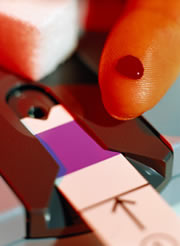Diabetes can be detected by breathing test
Physicists who have developed a simple breath test can help detect type 1 diabetes.
The results of the study were presented at the meeting of the American Physical Society in Denver, Colorado on March 5, which could lead to methods to test the disease without damaging the skin, It's even possible to create a nice new device to control daily glucose without having to extract blood.
Type 1 diabetes is only at an early stage when the body will not produce insulin chemicals used to break glucose, and as a result, increased blood sugar levels can cause patients to lose blood, even Releases after a long time can lead to blindness, kidney failure and heart disease.And make the breath smell of fruit .
Currently, type 1 diabetes is detected by extracting a small amount of blood and measuring the concentration of glucose in it. However, according to Armstrong Mbi, a student who has just graduated from Mississippi State University, we can also detect the disease through breath before people can detect the fruity breath.
 Mbi and consultant Wang Wang have developed a new technique to detect acetone, one of the chemicals in the lungs when blood sugar levels rise.
Mbi and consultant Wang Wang have developed a new technique to detect acetone, one of the chemicals in the lungs when blood sugar levels rise.
The team conducted injections of acetone-filled steam into a small compartment with mirrors in both matches. Then project infrared rays sensitive to acetone in this compartment. By measuring the amount of time that light is completely weakened by flickering between mirrors, these two ways can help detect the amount of acetone that drops to a concentration of about 0.45 parts per million (ppmv ).
Mbi said that previous tests showed typical diabetes with acetone levels greater than 1.4 ppmv. And based on his new test method, he said he could tell you if you have diabetes.
No more needles
According to Matt Petersen, director of information for the American Diabetes Association in Alexandria, this new technique seems to have potential. Current tests are also quite accurate but require more blood samples. However, it is better for techniques that do not need to extract blood, and if the technique can be developed with a daily blood sugar test it would be great.
Current testing is to extract blood from your fingertips several times a day to check your blood sugar. Although only a small amount of blood is removed, it is still a process of skin invasion.
Researchers have continued to conduct many experiments to achieve the goal, including the exploitation of a watch-like device that measures the amount of glucose in a fluid extracted by electricity from sweat glands. These devices are useful for detecting the direction of glucose during the day, but this does not mean it will be able to replace blood testing, because it is very expensive and likely to fail if the wearer it sweats.
Consultant Wang said they still conducted the experiment despite discovering the disease more than breathing, but there is still much to do to describe the relationship between acetone in the breath and blood glucose. He asserted that there may be many holes now but we can confidently overcome them.
Anh Phuong
- Stomach cancer is detected through breathing
- What is diabetes? Causes and ways to treat diabetes
- The boy's death left 4 words T
- Diabetic devices detect breathing
- Practice breathing for full body health
- Vaccines for type 1 diabetes will be tested on humans in 2018
- Diabetic identification signs: Much thirst ...
- 5 dishes from diabetes room beans
- Classify 5 diabetes groups for treatment of target
- Diabetes, things you can't ignore
- Simple breathing techniques help you relieve psychological stress right away
- After you see these signs appear, the risk of diabetes is very high
 Green tea cleans teeth better than mouthwash?
Green tea cleans teeth better than mouthwash? Death kiss: This is why you should not let anyone kiss your baby's lips
Death kiss: This is why you should not let anyone kiss your baby's lips What is salmonellosis?
What is salmonellosis? Caution should be exercised when using aloe vera through eating and drinking
Caution should be exercised when using aloe vera through eating and drinking